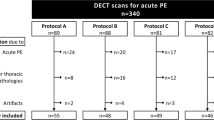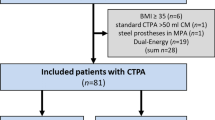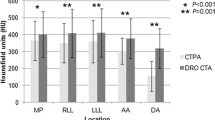Abstract
Objective
To compare the image quality of computed tomography pulmonary angiography (CTPA) obtained with the injection of various low doses of contrast medium (CM) with different injection-related factors.
Methods
A total of 90 patients (42 females, 48 males; 54.3 ± 18.6 years) undergoing CTPA were included. Three CM protocols, each containing 30 patients, were created. Protocols 1, 2 and 3 consisted of a CM of 60 ml, 55 ml and 50 ml, and a bolus trigger level of 120 HU, 90 HU and 75 HU, respectively. Injection was uniphasic for protocols 1 and 2 (flow rate 5 ml/s), and biphasic for protocol 3 (flow rates 5 and 4 ml/s); with saline flushing afterwards. Enhancement was measured in three central and six peripheral pulmonary arteries.
Results
The mean attenuation value for pulmonary arteries was over 250 HU for all protocols. There was no difference between the attenuation levels with the protocols (p > 0.05). The percentage of pulmonary arteries exceeding optimal attenuation (≥250 HU) showed that protocols 2 and 3 were 90–100% successful (p < 0.05).
Conclusion
The use of proper injection-related factors during CTPA, such as a low trigger level and a high flow rate with saline injection following a decreased CM volume (55 ml or 50 ml), will enable adequate pulmonary artery contrast enhancement.


Similar content being viewed by others
References
Raptopoulos V, Boiselle PM (2001) Multi-detector row spiral CT pulmonary angiography: comparison with single-detector row spiral CT. Radiology 221:606–613
Schoepf UJ, Holzknecht N, Helmberger TK et al (2002) Subsegmental pulmonary emboli: improved detection with thin-collimation multi-detector row spiral CT. Radiology 222:483–490
Hogg K, Brown G, Dunning J et al (2006) Diagnosis of pulmonary embolism with CT pulmonary angiography: a systematic review. Emerg Med J 23:172–178
Bae KT, Tao C, Gürel S et al (2007) Effect of patient weight and scanning duration on contrast enhancement during pulmonary multidetector CT angiography. Radiology 242:582–589
Lee CH, Goo JM, Lee HJ, Kim KG, Im J, Bae KT (2007) Determination of optimal timing window for pulmonary artery MDCT angiography. AJR Am J Roentgenol 188:313–317
Schoellnast H, Deutschmann HA, Berghold A, Fritz GA, Schaffer GJ, Tillich M (2006) MDCT angiography of the pulmonary arteries: influence of body weight, body mass index, and scan length on arterial enhancement at different iodine flow rate. AJR Am J Roentgenol 187:1074–1078
Yankelevitz DF, Shaham D, Shah A, Rademacker J, Henschke CI (1998) Optimization of contrast delivery for pulmonary CT angiography. Clin Imaging 22:398–403
Washington L, Gulsun M (2003) CT for thromboembolic disease. Curr Probl Diagn Radiol 32:105–126
Schoepf UJ, Costello P (2004) CT angiography for diagnosis of pulmonary embolism: state of the art. Radiology 230:329–337
Qanadli SD, Hajjam ME, Mesurolle B et al (2000) Pulmonary embolism detection: prospective evaluation of dual-section helical CT versus selective pulmonary arteriography in 157 patients. Radiology 217:447–455
Ghaye B, Szapiro D, Mastora I et al (2001) Peripheral pulmonary arteries: how far in the lung does multi-detector row spiral CT allow analysis? Radiology 219:629–636
Remy-Jardin M, Tillie-Leblond I, Szapiro D et al (2002) CT angiography of pulmonary embolism in patients with underlying respiratory disease: impact of multislice CT on image quality and negative predictive value. Eur Radiol 12:1971–1978
Tilie-Leblond I, Mastora I, Radenne F et al (2002) Risk of pulmonary embolism after a negative spiral CT angiogram in patients with pulmonary disease: 1-year clinical follow-up study. Radiology 223:461–467
Kubo S, Tadamura E, Yamamuro M et al (2006) Thoracoabdominal-aortoiliac MDCT angiography using reduced dose of contrast material. AJR Am J Roentgenol 187:548–554
Andreou AK, Curtin JJ, Wilde A, Clark A (2008) Does pregnancy affect vascular enhancement in patients undergoing CT pulmonary angiography? Eur Radiol 18:2716–2722
Schaefer-Prokop C, Prokop M (2008) CTPA for the diagnosis of acute pulmonary embolism during pregnancy. Eur Radiol 18:2705–2708
U-King-Im JM, Freeman SJ, Boylan T, Cheow HK (2008) Quality of CT pulmonary angiography for suspected pulmonary embolus in pregnancy. Eur Radiol 18:2709–2715
Roggenland D, Peters SA, Lemburg SP, Holland-Letz T, Nicolas V, Heyer CM (2008) CT angiography in suspected pulmonary embolism: impact of patient characteristics and different venous lines on vessel enhancement and image quality. AJR Am J Roentgenol 190:W351–W359
Arakawa H, Kohno T, Hiki T, Kaji Y (2007) CT pulmonary angiography and CT venography: factors associated with vessel enhancement. AJR Am J Roentgenol 189:156–161
Hartmann IJ, Lo RT, Bakker J, de Monye W, van Waes PF, Pattynama PM (2002) Optimal scan delay in spiral CT for the diagnosis of acute pulmonary embolism. J Comput Assist Tomogr 26:21–25
Bae KT, Heiken JP, Brink JA (1998) Aortic and hepatic contrast medium enhancement at CT. Part 1. Prediction with a computer model. Radiology 207:647–655
Eyer BA, Goodman LR, Washington L (2005) Clinicians’ response to radiologists’ reports of isolated subsegmental pulmonary embolism or inconclusive interpretation of pulmonary embolism using MDCT. AJR Am J Roentgenol 184:623–628
Revel MP, Petrover D, Hernigou A, Lefort C, Meyer G, Frija G (2005) Diagnosis pulmonary embolism with four-detector row helical CT: prospective evaluation of 216 outpatients and inpatients. Radiology 234:265–273
Schoep UJ, Holzknechnt N, Helmberger TK et al (2002) Subsegmental pulmonary emboli: improved detection with thin-collimation multi-detector row spiral CT. Radiology 222:483–490
Kim T, Murakami T, Takahashi S et al (1998) Effects of injection rates of contrast material on arterial phase hepatic CT. AJR Am J Roentgenol 171:429–432
Fleischmann D, Rubin GD, Bankier AA, Hittmair K (2000) Improved uniformity of aortic enhancement with customized contrast medium injection protocols at CT angiography. Radiology 214:363–371
Bae KT, Tran HQ, Heiken JP (2000) Multiphasic injection method for uniform prolonged vascular enhancement at CT angiography: pharmacokinetic analysis and experimental porcine model. Radiology 216:872–880
Remy-Jardin M, Mastora I, Remy J (2003) Pulmonary embolus imaging with multislice CT. Radiol Clin North Am 41:507–519
Cademartiri F, Nieman K, van der Lugt A et al (2004) Intravenous contrast material administration at 16–detector row helical CT coronary angiography: test bolus versus bolus-tracking technique. Radiology 233:817–823
Haage P, Schmitz-Rode T, Hubner D, Piroth W, Gunther RW (2000) Reduction of contrast material dose and artifacts by a saline flush using a double power injector in helical CT of the thorax. AJR Am J Roentgenol 174:1049–1053
Hopper KD, Mosher TJ, Kasales CJ, TenHave TR, Tully DA, Weaver JS (1997) Thoracic spiral CT: delivery of contrast material pushed with injectable saline solution in a power injector. Radiology 205:269–271
Schoellnast H, Tillich M, Deutschmann MJ, Deutschmann HA, Schaffler GJ, Portugaller HR (2004) Aortoiliac enhancement during computed tomography angiography with reduced contrast material dose and saline solution flush: influence on magnitude and uniformity of the contrast column. Invest Radiol 39:20–26
Schoellnast H, Deutschmann HA, Fritz GA, Stessel U, Schaffler GJ, Tillich M (2005) MDCT angiography of the pulmonary arteries: influence of iodine flow concentration on vessel attenuation and visualization. AJR Am J Roentgenol 184:1935–1939
Acknowledgements
This study was presented as a scientific exhibit at ECR 2010.
Author information
Authors and Affiliations
Corresponding author
Rights and permissions
About this article
Cite this article
Uysal Ramadan, S., Kosar, P., Sonmez, I. et al. Optimisation of contrast medium volume and injection-related factors in CT pulmonary angiography: 64-slice CT study. Eur Radiol 20, 2100–2107 (2010). https://doi.org/10.1007/s00330-010-1782-y
Received:
Accepted:
Published:
Issue Date:
DOI: https://doi.org/10.1007/s00330-010-1782-y




